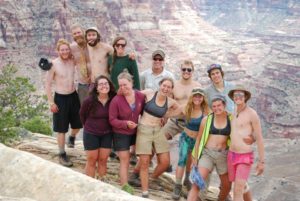 We sat with the stream, and talked about what we saw. In the expansive desert of the Colorado Plateau, the pockets of water are the islands. What organisms live here, and what do they do when these seasonal streams dry up? How do the plants survive the drought and the flood? We observe the water strider bugs on the surface of the water. Their larval stages are spent in the intermittent streams, then, corresponding to the dry season, they grow wings as adults and are able to move. We noticed the brush high in the trees and shrubs growing in the wash. Do the spring floods reach that high? Along the canyon wall is another clue- a line between smooth, weathered rock and rough, jagged rock. This stream, now low and calm, becomes a roaring river with the spring floods.
We sat with the stream, and talked about what we saw. In the expansive desert of the Colorado Plateau, the pockets of water are the islands. What organisms live here, and what do they do when these seasonal streams dry up? How do the plants survive the drought and the flood? We observe the water strider bugs on the surface of the water. Their larval stages are spent in the intermittent streams, then, corresponding to the dry season, they grow wings as adults and are able to move. We noticed the brush high in the trees and shrubs growing in the wash. Do the spring floods reach that high? Along the canyon wall is another clue- a line between smooth, weathered rock and rough, jagged rock. This stream, now low and calm, becomes a roaring river with the spring floods.
This is our classroom- the Dark Canyon Wilderness, the Colorado Plateau, the world itself. I am writing this from under a ponderosa pine, my back to its bark and seated on a bed of its dry needles scattered with open cones. Its branches shield me from the light sprinkling coming from the grey clouds above.
Place-based learning gives you knowledge and connection like no lecture hall or textbook can. The best way to learn about the natural world is to get out into it- to walk through its deserts, forests, and rivers. To touch the layers of rock as you learn their names, to watch the birds and hear them sing. Throughout this course, we have walked through the Colorado Plateau. We toured the Glen Canyon Dam and saw for ourselves the affects it has on the landscape. Upriver, Lake Powell looms as an expansive body of water in the middle of this desert. Bathtub rings on the canyon walls show how full this reservoir was at its fullest, hundreds of feet above where the water is now. Downstream, the change in flood patterns caused by the dam’s regulations of water release has allowed invasive species like tamarisk to take over, crowding out the native species and affecting the ecology of the area.
These are our teachers- every flower we stop to smell; every speaker, local, and expert we have talked to. We are always learning. From reading about the endangered condor, to talking with the condor specialist for the state of Arizona, to seeing two condors in the wild warming their outspread wings in the sun in the same day.
We learned about the ancient people who lived here thousands of years ago, hiked to the ruins of their granaries, looked up at their pictographs, walked by their pottery shards and arrowheads scattering the ground, and meeting their descendants- the Hopi people. We stayed on the Hopi reservation, and planted corn in the traditional dry land farming method- with no watering. We butchered a sheep with the Navajo people, partook in a traditional sweat, and discussed current problems on the reservation, like diabetes and high unemployment rates.
We saw the effects of grazing on the landscape by crossing the boundary between heavily grazed BLM land and ungrazed Canyonlands National Park land. We crossed from barren desert of rock and sand to one full of life. We talked to BLM employees, park rangers, and locals about these grazing problems to get the full picture.
Getting all sides of issues, and learning to understand the complexity and dynamic-ness of our systems has been a theme of this course. Take this a step further- use this knowledge and apply it to your own life. In learning about this landscape, I have learned about myself. This experience has made me really excited about my own education. I love natural history; making observations and speculations, and understanding the interworking of the natural world. I’ve realized how much you can learn about a place by being in it and paying attention. Look around you- notice which plants grow where, cottonwoods in washes and ponderosas at high elevations. Notice the millions of years of built up rock, cut down by water into red canyons. The earth is in a constant state of change, covered in plants and animals constantly adapting to keep up. There is so much to learn about this world, and the best place to do that is out in the middle of it!
One Reply to “Elly Voigt: Experiencing the Colorado Plateau”
Comments are closed.
Great writing Elly, wish i had been out there with you all this year. Hope you continue getting out there and connecting with places you love!